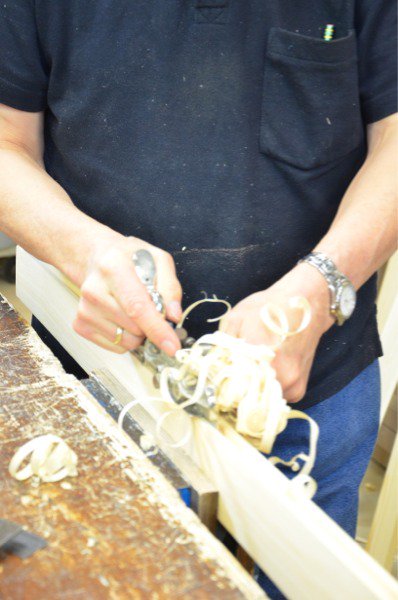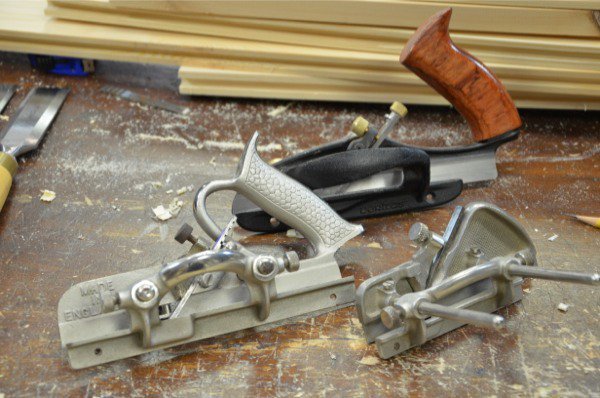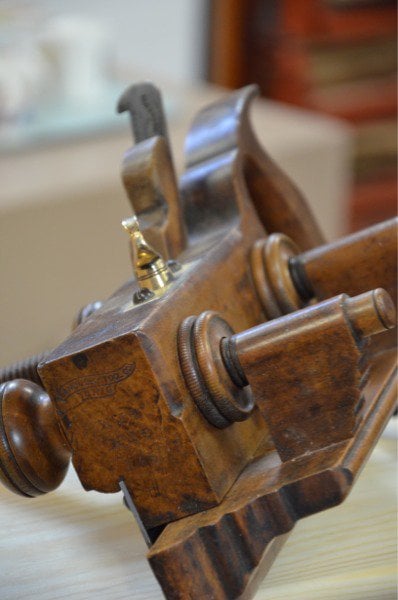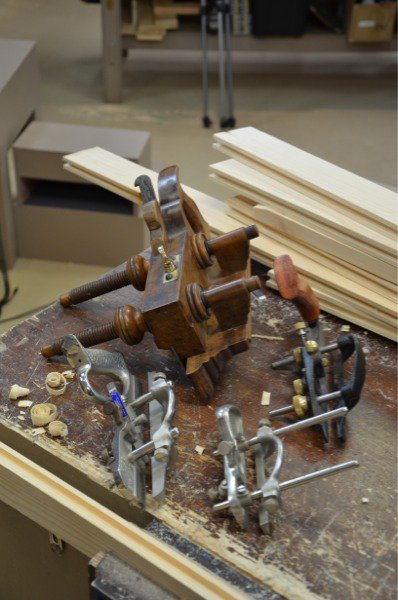On Plough Planes and Ploughing – Just Thoughts
For more information on plough planes, see our beginner site Common Woodworking.
Considering plough planes past and present
I have ploughed grooves for 50 years and used every type of plough plane I think. Just about any way. I’m not old fashioned, I just like the upper body exercise, the self discipline of hand work, breathing good air that isn’t exhaled into a fabric mask and being able to hear clearly each stroke I take. My hands may ache just a little some times, but my body is never as tensely stressed as it is when a screaming router pulls against me and threatens my sanity and peace. The plough pulls me gently to task and somehow I enjoy uniting my senses to the cutting iron as it slices through each layer of wood. What I feel has nothing to do with nostalgia but life. My wellbeing relies on my senses being stirred and stimulated. I hear and see, smell smells I cannot smell by any other means,and my tongue tastes the essence of the wood I work by being transferred through the air. Friction becomes critical to this, but who understands what takes place when I rive and split, saw, plane and chop. I feel oak differently than cherry and walnut differs so markedly from pine and yew and ash. Green wood too has distinctive smells and sounds as I work the fibres.
The reason I like plough planes is because they work their way so readily into the wood no matter the wood I work. The irons are narrow, not like smoothing planes, and so I can plough wood taking shavings four times thicker than when I smooth wood with a smoothing plane. The grooves go down quickly for me no matter which plough plane I use. In some measure they are all my favourites really.
The Record 043 (bottom right) is punchy, compact, stoutly built and as stocky as a Haflinger. It’s very direct, comfortable and vibration free no matter the grain terrain. It’s quick to set up, easy to adjust and lends itself to tight control even with only one hand if needed.
The Record 044 has adjustment (left) but needs a screwdriver to set the depth. The advantage of this is the fence doesn’t slip. The metal handle is more comfortable than it looks for an all metal handle though in a cold shop it takes a minute to warm in the hand and in a really cold shop robs the hand of all heat. A fingerless gloved hand takes care of this. I love this plane too and rank it as more an Arabian gelding for its flightier appearance but solid dependability. There are two or three on ebay right now. One at a buy-it-now of £45, which I consider a good and fair price because all of the parts and cutters seem to be there and condition looks nice too. There’s another buy-it-now for £20 but only has one cutter so would need buying more or making them as needed. Cutting irons always come up for £3 each and free shipping. Still a good price fora working plough.
I suppose the Thoroughbred in the stable is the Veritas (top) which almost mirrors the Record 044c with refinements and a current-day increase in cost. I think it definitely equals the 044 and the 044c in the hand and the wooden handle is nice and solid.
Percherons are powerful through and through. French heavyweights used as power-filled war horses. So strong and resilient, unfaltering in tackling awkward grains; handling any and all woods. That’s the old, wooden, handled plough plane. I bought this Sandusky plough a couple of years ago and since then i have enjoyed using it as well and as much as any other. My Marples screw-stem handled version will always be my favourite amongst the ploughs, but I like using this one too.
Today I ploughed the grooves in the back frame of my bookcase using the plough. It took about three-quarters of an hour of vigorous work but it wasn’t hard work particularly. The working height of 40” is as perfect as it can be. Very direct to my arm and shoulder-line thrust.
The difference between these four ploughs I used today is minimal. The wooden Sandusky is the best and lightest in use even though the plane weighs more than all the others. That’s the effect of wood on wood. Near frictionless motion makes a big difference. I don’t know of any modern day planemaker making wooden ploughs, but if they did copy a Sandusky like this one they would sell them readily. provided they could match the quality of the Sandusky. This took skilled work and was the primary reason for the demise of the wooden plough plane. In every step toward industrialized production came a reduction in the need for quality skilled workers who could work the more refined areas of plane making. The all metal planes take minimal skill to make. Bolt on, bolt in components for assembly-line production using a series of engineering processes meant lower cost products, reduced skill sets and faster manufacture. With diminished skill levels, the plane making process replaced the highly skilled work of the plane maker irreversibly and nowhere is this seen more than in the making of plough planes.






I bought my record combination plane in 1972. It will never be a Sandusky of course but it continues to serve me well and plows beautifully.
Speaking of metal versus wood planes, I have constantly pondered why the old transition planes are not favored (understanding of course bottom wear) by any one except boat builders who like their light weight when working hands above head. I wonder what your view is on using transitional planes. I have never seen a transitional plow plane. Do they even exist?
You can add a wooden fence to your metal plough plane. It is done quite often and works like a charm 🙂
It’s shocking to me too, that I don’t see them being used. I have several in storage in The US and look forward to being reunited with them. The soles really don’t wear out that quickly and can be re flattened easily for continued use. They can also be readily replaced. I think they were really excellent planes and am surprised nobody relocates them too.
There is a Sandusky plough plane on eBay at the moment. An object of classical beauty with a buy it now price of £350. It’s a lot of money, but it’s a lot of plane! It’s so gorgeous looking, you can understand why collectors covet them. But really it should be in the hands of a woodworker for a tenth that price, imho
Yeah, you are right. I think I paid £65 for mine and it was a good buy at that. It had 8 cutters all in good shape. When I pass I will make sure it goes to a user.
hello paul what are your thoughts on using router planes for flattening the cheeks of tenons?
Ray
They work fine for this and we use the method in all of our videos on woodworkingmasterclasses.com. Once the tenon gets longer you must add in an extra long plate to extend it otherwise it tips into the face of the tenon and gouges more than you want.
It ain’t cheap, but I’ve kept my eye on this for some time… My girlfriend hasn’t been picking up the hints I’ve been laying down either!
http://www.highlandwoodworking.com/ecefencedploughplane.aspx
I am sure this is a good tool. I had forgotten about EC Emerich. It would be a good tool to replace the body with a handled version.
Paul another great Blog, I have a Stanley #45 which is OK and a Wooden one made by Auburn Tool Co. with only ( 1 ) blade. For what ever reason I can’t seem yo get them to work well, probably the cutter is not sharp enough and I am using Home Depot’s “white” pine wood which isn’t the best either, I get a lot of tear out.
I believe Philly’s Plane makes a nice Wooden plough plane and he is in England. A fellow I know has bought several planes from Phil and swears by them.
Steve
Hi Steve
Check the buying good tools cheap entries on plough planes
https://paulsellers.com/2012/08/buying-good-tools-cheap-4/
I went through the trouble to make the adjustments on my irons and have much less problems since …
HTH
Diego
Thank You I have not read this Blog.
Steve
High Steve, I have a wood John Weiss & Sohn plough an it did not wotk fine either. Till I checked the alignment of the steel skates, they were hollow… So I had to set the iron far to steep and the plane was eating my wood. After I filed them flat, like the bottom of any other plane I was able to start the cut with a shallow cut, and that will take care of most of the tearout, sharp is off course equally importand…
have a go
Henk
Schwarz had posted about these a while back, too.
Think he had a wood plough from DL Barrett, which seem to still be in production, although at a premium price:
http://www.dlbarrettandsons.com/ploughgallery.html
Matt
Paul,
If there isn’t a video yet would you consider making one on how to setup and use a plough plane?
We have just done one on woodworkingmasterclasses.com as part of the Shaker Bookcase series, which means we will create a technique video on the plane and post it for free at some point in the near future. We took four different plough planes and used them to form the various grooves on the back panel. I think you will find it interesting. You will need to either be a paying member or a sign in as a free subscriber though. That means you can see any of our freebies as a non paying member. We try to make all techniques videos available to any and all.
Paul,
Is there a video yet on setting up and using plough planes?
Need to ask is the 50 with its further options on blades a real option and equal to that of the 44 or is it a different beast altogether and not as good as the 44 or 44c? Looking to pick one up now and wanted to settle it in my head before I made the purchase. Thanks in advance.
This depends on what you want from your plane. I avoid the multi planes with bullnose cutters only because they lift the grain ahead of the cutting edge as there is no profile of the plane following the profile of the cutter. This then results in more tear out than shaped wood most often I am afraid. You are better off buying moulding planes for profiles and using any of the plough and multi planes for tongues and grooves and rabbets etc. The #50 is a good plane to own. It’s a bit like owning too much of something you don’t use and therefore don’t need. A bit like happens with the bench planes really. I do own a number 50 but don’t use it. I reach for my #44 or 043 most of the time. I also like the Veritas plough I have and use that a lot too.
I would say that using a plough plane is probably the single woodworking activity I enjoy the most. There’s something about it that is just very satisfying and I find myself looking for ways to work grooves into my project just so I can use my Record 044.
Before I became a hand tool convert, I’d cut grooves with the table saw or router table. I’d be very tense and well aware of the danger both to myself or the work if I made one small slip.
Then I was watching some woodworking video and it briefly showed a plough plane in use, explaining that this was how grooves used to be cut, now replaced my more modern methods. I swear my jaw dropped. I thought, “That is PERFECT! Why would you replace that?” This was also before I knew how easy it is to get vintage tools on line, or the existence of Veritas and Lie Neilsen hand tools. So I was just sad that this method was not available to me anymore.
Of course, eventually I discovered this site and joined Woodworking Master Classes. Now my 044 is one of my prized possessions. I just made a new home for it this weekend. http://www.keithpeters.org/?p=1016
Mr. Sellers, thank you for what you do. My question is this, will a router plane suffice to cut the grooves a plough plane is used for? I’m trying trying to do more with less while I save money for each of these tools.
Thanks again,
Kevin
Not really, there is no sole ‘fore’ and ‘aft’ to the cutting iron. That said, I have used saws either side to form a groove and then set a router with a shallow cut and a wooden sole to span the groove and it will work.
Thank you sir.
I recently missed out on a Record 44 at eBay, and I’m writing about it because it had an extraordinary attachment, the like of which I have not seen mentioned anywhere. And it was a Record product intended for the plane. I’ve put the eBay website into the form here but understand that in time eBay will delete the information.
I’m talking about a sort of cam device that was attached to the forward fence rod, on the side opposite the fence, with a set screw. So that the angle of the cam could be readily adjusted with the setscrew. Overall the device had a half-moon shape, perhaps 2 inches in diameter. You rotated the cam so as to prop up the fence rod from underneath, I suppose.
My assumption is that it served as a sort of outboard depth stop, to better level the entire plane, such as when ploughing in a board that is too thin for the fence to provide good perpendicularity.
I have captured some photographs from the eBay website, should that site evaporate soon and in the event that Mr. Sellers reads this and is curious and hasn’t seen such an attachment (hard to imagine, but I’ve seen numbers of eBay adverts for Record 044’s and none of them had this).
Are you sure it was a Record 044? If so, it looks like it included parts from a Record 405. What you’re describing sounds like the “cam steady” shown on page 24 here: http://www.marquis-kyle.com.au/405.pdf . I have a 044 with the original box and all the parts. I love it, but it doesn’t have anything like that. And I haven’t seen that described in any other information about the 044.
Hello all,
First of all thank you Paul and all the people contributing to the knowledge of this fine art!!!
I am novice to fine woodworking but I am reading a lot and work on several projects with my dad building windows, doors and repairs, from time time.
I was looking into buying the 405 plane because of the “sash cutter” I think it is called for cutting ovolos?
Is the 405 plane as good as the 50 and 44 to work with? Or can I use other similar sash cutters with the 50 or 44?
Regards
Nikos
These planes rarely work well. they have always been over rated and difficult to set up to get the shavings you want, Nikos. You can get them to work but as soon as you change the cutter for another profile you have to start over again and they can take up to an hour of meticulous adjustment before you get good work from them. The best thing is to look for moulding (molding) planes. These can also take a little setting up but much less than multi planes and they are dedicated to shape so you do need to buy individual moulds. Here on the UK eBay they sell for as little as £2 but more likely around £12. these are lifetime planes and they get the job done with very little hassle.
Wow Paul, you replied so fast!!!
I am glad you have confirmed my thinking.
Should I go for 044 or 050 then in order to be able to make some grooves and beading?
Thank you so much!!!
PS: Since you are now in UK we could probably watch one of your classes live:)
Paul,
I wholeheartedly agree with your assessment of the Sandusky plane and as a budding plane maker myself sit in awe at the craftsmanship that was present back then. I am currently making a plow, know others that can make them and given time could operationalize into producing them for sale. I don’t think the problem is a lack of able bodied craftsman, there are many that are capable and can be taught, but I think the problem is what it would cost to produce them. Given the scarcity in the supply of plane makers the labor rate naturally increases, I calculate in the US it would be in the $40-$50/hr range. (By the way my auto mechanic charges $100/hr). Now, figuring how long it takes to make a plow by hand, using some power to rough in the material, a finished plow of this quality would likely cost $500-$700.
Now for the real problem: there just aren’t enough people willing to pay that much. Even with the hollows and rounds I make I hear “wow, that costs 8-10x what a pair on eBay costs”. I’m not making a ton of money on them, perhaps a 20% gross margin, so I’m not buying a mansion any time soon. But… I have to make something out of it so it’s worth my while, I’m not a non-profit. People just don’t understand what it takes to produce a high quality, hand made product anymore, they’re too used to cheap and fast.
So, it’s really unfortunate but because of that I don’t see anyone making modern wooden plow planes. And it’s because of that the plane making trade will ultimately die unless people like me continue to make them. But, to be honest, there’s not much reason to do so.
I’m afraid too that hollows and rounds have very limited use in today’s woodworking world. Even I rarely have much use for them to be honest.
How can I obtain / make a1/8″cutter and depth stop for record 44 plane.The rest of the plane is complete.
Try Tool Exchange in Australia. Do a quick web search. Cheers!
Hi Mr. Sellers.
Do you know where and how I could get sufficiently precise blueprint of Sandusky plough plane ?
I would like to give a serious try at making at least some for my personnal use.
Thanks for all you do.
I own a beautiful Sandusky, which I guess prompted your question. I only have the plane and not the drawings so, no, I don’t know where you will get the fine details you need I am afraid.
I learned after much research that wooden plough planes were often sold without cutters, or that merchants matched cutters from other manufacturers with the planes. So, there seems to be a “standard” in snecked cutters that would fit many brands of plough planes.
As for moving fillester planes (how DO we spell that!?), the planes with moving fences on extended arms (screw or wedge) have not the configuration for scoring spurs to cut crossgrain. The fences that are fixed underneath (the sole) with inset fixing screws do have this facility, often for spurs on either side of the cutting blade. As the fence is adjusted to the width of the cutting blade, so are the scoring spurs.
Therefore, an inexpensive Marples with arms holding the fence is fine for grooving with the grain, but not crossgrain. I just bought the Marples plane, then found an inexpensive graduated set of 8 cutters that will fit it.
Question: can spurs be somehow retrofitted to score groove edges crossgrain on the wooden plough planes that use arms for fences, but have no scoring spurs?
Question: can the zillions of Stanley (and others’) combination cutters from 45’s and 50’s, etc., be retrofitted to be used on the wooden moving fillester planes? They are configured differently, but I’m a novice to this sort of planing. The wooden planes really are works of art.
What angle would you sharpen a 1/4″ cutter for the Stanley #50 plough?
All plane irons are sharpened at 25-30 degrees.
Hello,
I have a question – is there a source for replacement parts of wooden plow planes? In particular, I need a wooden threaded lock ring to keep the fence in place once adjusted with the threaded knobs. Can anyone help me with my dilemma?
Thank you, Roger
No, Roger, no such supplier. It would be unlikely you would find a replacement I’m afraid.
Hi Roger,
What you’re looking for is very difficult. I’ve tried to find the same part as you did. I would suggest maybe looking for a donor plane on ebay. If you do that though make sure that part is complete. Even though they may be the same threads ie.. 3/4″ x 6TPI unless they’re from the same manufacturer there’s a good chance they will be different enough that they won’t screw together and then I wouldn’t bet on them being the same even then. If it’s not damaged to badly you can search the internet and find ways to repair them. I hope this helps. Take care.
BillS
What’s the outer diameter and threads-per-inch of the threaded rods on your plow plane?
I’ve been considering making a tap for plow plane arms.
Sorry, I don’t have the information to hand for you. I am sure it is of little consequence to find an exactly matching pitch or thread count though.
Hi Paul, can the plough plane be used for a rebate plane (like the 778)? Which would you get first, plough plane or rebate plane? I already have a vintage wooden rebate plane, 1″ wide, skew blade but no side-cutter or fence. Haven’t used if for rebates yet.
I was recently offered some old wooden planes with fences, they all looked similar (but different brands) but some had wide blades (rebate planes?) and some a narrow blade (plough planes?). But didn’t quite know what to make of such a haul. The fences were all held with wedges rather than wooden thread and nut.
Does anyone know if they manufactured tongue and groove/match irons for the sandusky (and similar) wood ploughs? having trouble finding any.
I supposed some careful persistance with the correct file and i could create my own from a wider iron…but that’s not my favorite idea.